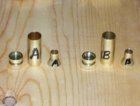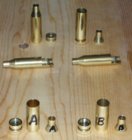Ned Ludd
Silver $$ Contributor
Cases that have fully expanded to match the chamber (pressure cell) dimensions are VERY uniform in their external dimensions. Thus, the only real parts of the case that might affect weight without affecting internal volume are the extractor groove and the primer pocket. In my experience, both are also VERY uniform. A difference in brass thickness anywhere else will by definition affect the internal volume if the external dimensions are uniform. For that reason, if case weight was not proportional to case volume, it would not be possible to obtain a scatter plot for which the best straight line plot of case weight versus case volume has a negative slope, and a linear correlation coefficient in the 0.7 to 0.9 range. I've weighed and determined water volume for hundreds, if not thousands of cases over the years, and the corresponding scatter plot best straight lines always have these two characteristics.
Of course there are always a few outliers. As I stated earlier, I believe many of those outliers are more likely due to error due in the actual determination/measurement of internal water volume than in the true volume value itself. Accurate determination of internal water volume of cases is subject to a number of potential sources of error including bubbles, uniformity of the meniscus, etc. It takes a great deal of care to obtain consistent case water volume measurements, something I've practiced many times using a single piece of brass repeatedly.
The main point I'm trying to make is very simple. Sorting cases by weight can yield more consistent internal volume than doing nothing at all. It's really that simple. I'm not making any over the top claims about absolute case volume accuracy, potential sources of error, the existence of outliers, etc.; merely that the statistics support the notion that weight sorting cases can lead to more uniform internal volume than not sorting. Because weight sorting on a good balance is much faster,easier, and likely more consistent, than accurate determination of water volume, I believe it is a useful surrogate for sorting brass as compared to directly measuring the internal water volume of large numbers of cases.
So - the real [important] question as you correctly pointed out above is whether the modest improvement in case volume consistency obtained by weight sorting cases is large enough to make a difference that can be detected by other means such as muzzle velocity or vertical dispersion on a target. In my hands, the difference in sorted cases is sufficient to detect using a chronograph. It is more apparent with a small case such as the .223 Rem, where the velocity of the heaviest weight group can differ from the lightest by as much as 20-30 fps. It has less of an impact on .308 Win cases, although I do it for match loads anyhow, because it takes such a minimal effort.
I generally view anything that might improve the consistency of muzzle velocity in the long strings of fire (25+) we shoot in F-Class as potentially of benefit. It all boils down to what is the cost of a given step in the reloading process in terms of time and effort. Like certain other things we do in the reloading process, it is not always easy to demonstrate true statistical significance beyond any shadow of doubt. Nonetheless, we do certain things anyhow, especially if they do not require substantial effort. I would also point out that the impact of weight sorting brass is also likely proportional to the consistency of a given Lot# of brass. The more consistent the weight/volume of the brass to begin with, the less the benefit of weight sorting. I've had Lot #s of brass that were pretty uniform straight out of the box (after processing and fire-forming). In contrast, my last couple Lot #s of Lapua .223 Rem brass had about one in every five or six cases that weighed substantially more than the others, and it was those cases that gave 20-30 fps greater velocity from otherwise identical loads. Sorting those cases into 4 weight groups most definitely made a difference in ES/SD as compared to not sorting them at all.
The bottom line is that the science behind sorting cases by weight as a surrogate for internal volume is solid. Not "perfect", as there will always be a few outliers, but solid. Like almost anything else, it is up to the individual to test for themselves and determine whether sorting cases by weight provides a detectable or measurable benefit. If not, then it can certainly be argued that it may not be worth the effort for every reloader, regardless of how solid the science behind it may be. However, if there is a detectable benefit, even a very small one, I am one that will likely carry out that particular process. In the F-Class game, even one or two points or Xs can be the difference between winning and not winning. I don't believe that I can win a match at the reloading bench; I still have to point the rifle in the correct direction for whatever the wind is doing at that moment. However, I do believe that I can lose a match at the reloading bench. Bringing the best possible ammunition I can reload to every match I participate in means that all I really have to worry about when laying behind the rifle is what the wind is doing. I believe that sorting cases by weight improves the internal case volume consistency, and therefore leads to more uniform velocity and elevation on the target during a string of fire. Statistical analysis of case weight versus case volume support this belief.
Of course there are always a few outliers. As I stated earlier, I believe many of those outliers are more likely due to error due in the actual determination/measurement of internal water volume than in the true volume value itself. Accurate determination of internal water volume of cases is subject to a number of potential sources of error including bubbles, uniformity of the meniscus, etc. It takes a great deal of care to obtain consistent case water volume measurements, something I've practiced many times using a single piece of brass repeatedly.
The main point I'm trying to make is very simple. Sorting cases by weight can yield more consistent internal volume than doing nothing at all. It's really that simple. I'm not making any over the top claims about absolute case volume accuracy, potential sources of error, the existence of outliers, etc.; merely that the statistics support the notion that weight sorting cases can lead to more uniform internal volume than not sorting. Because weight sorting on a good balance is much faster,easier, and likely more consistent, than accurate determination of water volume, I believe it is a useful surrogate for sorting brass as compared to directly measuring the internal water volume of large numbers of cases.
So - the real [important] question as you correctly pointed out above is whether the modest improvement in case volume consistency obtained by weight sorting cases is large enough to make a difference that can be detected by other means such as muzzle velocity or vertical dispersion on a target. In my hands, the difference in sorted cases is sufficient to detect using a chronograph. It is more apparent with a small case such as the .223 Rem, where the velocity of the heaviest weight group can differ from the lightest by as much as 20-30 fps. It has less of an impact on .308 Win cases, although I do it for match loads anyhow, because it takes such a minimal effort.
I generally view anything that might improve the consistency of muzzle velocity in the long strings of fire (25+) we shoot in F-Class as potentially of benefit. It all boils down to what is the cost of a given step in the reloading process in terms of time and effort. Like certain other things we do in the reloading process, it is not always easy to demonstrate true statistical significance beyond any shadow of doubt. Nonetheless, we do certain things anyhow, especially if they do not require substantial effort. I would also point out that the impact of weight sorting brass is also likely proportional to the consistency of a given Lot# of brass. The more consistent the weight/volume of the brass to begin with, the less the benefit of weight sorting. I've had Lot #s of brass that were pretty uniform straight out of the box (after processing and fire-forming). In contrast, my last couple Lot #s of Lapua .223 Rem brass had about one in every five or six cases that weighed substantially more than the others, and it was those cases that gave 20-30 fps greater velocity from otherwise identical loads. Sorting those cases into 4 weight groups most definitely made a difference in ES/SD as compared to not sorting them at all.
The bottom line is that the science behind sorting cases by weight as a surrogate for internal volume is solid. Not "perfect", as there will always be a few outliers, but solid. Like almost anything else, it is up to the individual to test for themselves and determine whether sorting cases by weight provides a detectable or measurable benefit. If not, then it can certainly be argued that it may not be worth the effort for every reloader, regardless of how solid the science behind it may be. However, if there is a detectable benefit, even a very small one, I am one that will likely carry out that particular process. In the F-Class game, even one or two points or Xs can be the difference between winning and not winning. I don't believe that I can win a match at the reloading bench; I still have to point the rifle in the correct direction for whatever the wind is doing at that moment. However, I do believe that I can lose a match at the reloading bench. Bringing the best possible ammunition I can reload to every match I participate in means that all I really have to worry about when laying behind the rifle is what the wind is doing. I believe that sorting cases by weight improves the internal case volume consistency, and therefore leads to more uniform velocity and elevation on the target during a string of fire. Statistical analysis of case weight versus case volume support this belief.
















